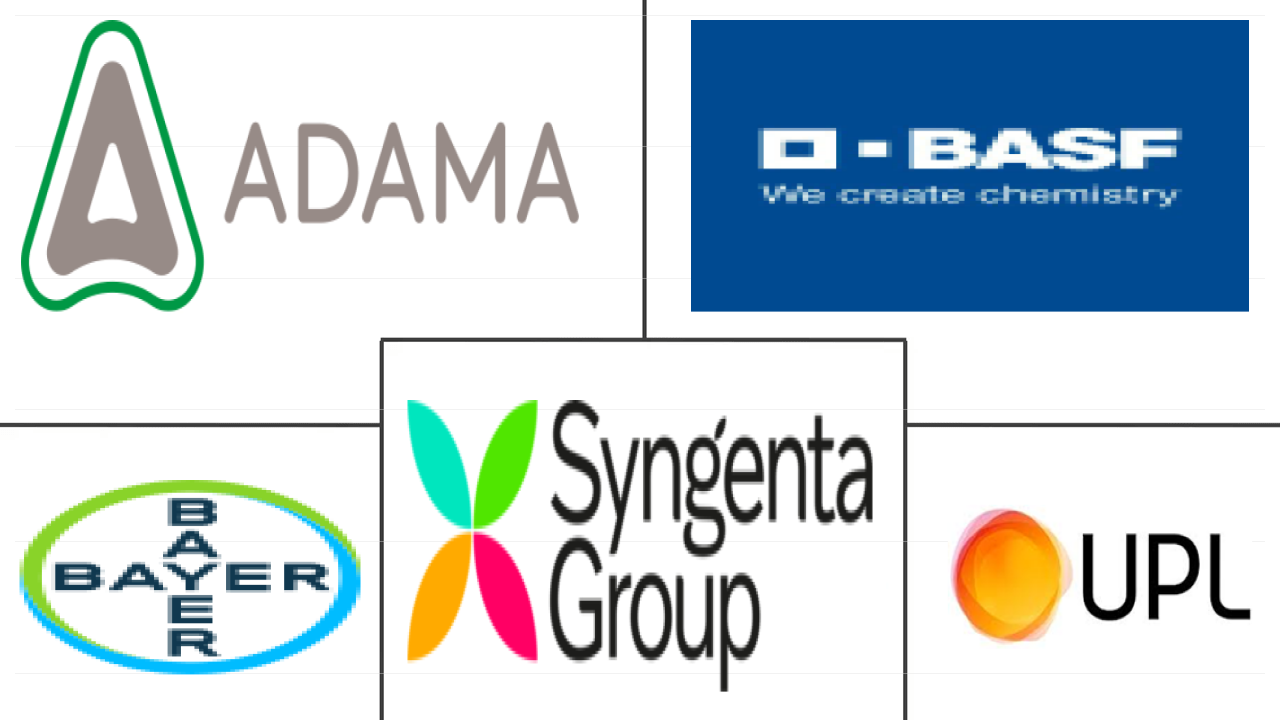Market Size of asia pacific fungicide Industry
| Icons | Lable | Value |
|---|---|---|
|
|
Study Period | 2017 - 2029 |
|
|
Market Size (2024) | USD 3.36 Billion |
|
|
Market Size (2029) | USD 4.05 Billion |
|
|
Largest Share by Application Mode | Foliar |
|
|
CAGR (2024 - 2029) | 3.78 % |
|
|
Largest Share by Country | China |
Major Players |
||

|
||
|
*Disclaimer: Major Players sorted in no particular order |
Asia Pacific Fungicide Market Analysis
The Asia Pacific Fungicide Market size is estimated at 3.36 billion USD in 2024, and is expected to reach 4.05 billion USD by 2029, growing at a CAGR of 3.78% during the forecast period (2024-2029).
3.36 Billion
Market Size in 2024 (USD)
4.05 Billion
Market Size in 2029 (USD)
1.60 %
CAGR (2017-2023)
3.78 %
CAGR (2024-2029)
Largest Segment by Application Mode
60.68 %
value share, Foliar, 2023
Foliar fungicide application provides a more targeted approach and quick response to control various fungal diseases in major crops, resulting in market growth for foliar mode.
Largest Segment by Crop Type
56.80 %
value share, Grains & Cereals, 2023
Grains and cereals are highly susceptible to various devastating diseases like blight, which cause substantial crop losses, leading to higher usage of chemical fungicides.
Largest Segment By Country
38.40 %
value share, China, 2023
Higher cultivation areas and the increasing fungal disease infestation in major crops like cereals, fruits, and vegetable crops have increased fungicide use in the country.
Leading Market Player 1
26.35 %
market share, Syngenta Group, 2022

Syngenta invests more in R&D activities to expand its product portfolio by adding new products like TYMIRIUM technology-based fungicides, resulting in the growth of company strength.
Leading Market Player 2
13.81 %
market share, UPL Limited, 2022

UPL Limited strengthens its position by introducing new innovative products to its portfolio by acquiring companies like Arysta LifeScience, resulting in the company's growth.
The increased infestation of fungal diseases due to changing climatic conditions drives the market
- In 2022, the fungicides market witnessed the dominance of foliar application, holding a significant share of 60.6% with a value of USD 1.90 billion. This application method is preferred due to its ability to directly target and protect vulnerable plant parts from fungal diseases. By applying fungicides through the foliar application, leaves, stems, and above-ground plant tissues may effectively be safeguarded.
- Fungicide seed treatments are commonly used to combat fungal infections during the early stages of plant development. They form a protective barrier on the seeds, preventing diseases such as damping-off, seedling blights, and root rots. In the Asia-Pacific fungicide market, fungicide seed treatments held a substantial share of 13.9% in 2022.
- The market for chemigation was valued at USD 388.8 million in 2022. It is further estimated to grow owing to factors like its precise application, reduced labor costs, and increased efficiency in the distribution of fungicides throughout the field. The increase in the adoption of micro-irrigation systems in countries like China, India, and Australia is expected to aid the market’s growth.
- Applying fungicides to the soil allows for the uptake of fungicide molecules by plant roots, providing protection against soilborne fungal pathogens. These pathogens, such as Fusarium wilt, verticillium wilt, Phytophthora root rot, Pythium root rot, and Rhizoctonia root rot, pose significant threats to various crop types grown in the region. Soil application of fungicides effectively combats these destructive diseases.
- By utilizing different application methods, farmers may employ targeted approaches to protect their crops from fungal infections and enhance overall productivity.
China dominates the Asia-Pacific fungicide market
- Asia-Pacific is known for its diverse agricultural crops. Rice is a staple food in many countries, particularly in Southeast Asia, such as Thailand, Vietnam, and Indonesia. Other important crops include wheat, corn, soybeans, sugarcane, fruits, and vegetables. China and India are major producers of various crops, contributing significantly to the regional and global food supply.
- China dominated the Asia-Pacific fungicide market, accounting for a market share of 38.7% in 2022. Major fungicide classes in China include triazoles, strobilurins, benzimidazoles, dithiocarbamates, and quinone outside inhibitors (QoIs). These fungicides have different modes of action and target specific fungal pathogens.
- Japan is the second-largest consumer of fungicides, and it had a market share of 20.3% in 2022. Most of the grain and cereal crops in Japan are prone to serious soil-borne diseases that are caused by Helicobasidium mompa, Rosellinia necatrix, Annillaria mellea, and Rhizoctonia solani, which cause serious yield losses in economically important crops. These factors are further expected to increase Japan's demand for chemical fungicides while registering an estimated CAGR of 2.78% during the forecast period (2023-2029).
- The increasing need for food crops due to the region's population increase fueled the use of pesticides to enhance crop yield. In Southeast Asian countries and India, the arable land per person is decreasing at an alarming rate, where the use of fungicides can play an important role in increasing the average crop yields per hectare. Owing to the above reasons, the market is anticipated to record a CAGR of 3.7% during the forecast period.
